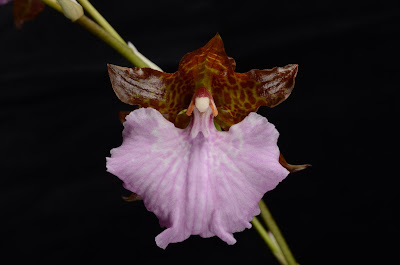Rhynchostele uroskinneri is native to Guatemala, in the Department of Solola, where it grows in the mountains on the slopes directed towards the Pacific, near Santa Catarina, at an altitude of 1800-2200 m...
Rhynchostele uroskinneri also called as Ure-Skinner's Rhynchostele, Amparoa uroskinneri, Cymbiglossum uroskinneri, Lemboglossum uroskinneri, Odontoglossum uroskinneri, is a species of the genus Rhynchostele. This species was described by John Lindley in 1859.
IDENTIFY RHYNCHOSTELE UROSKINNERI
Rhynchostele uroskinneri is native to Guatemala, in the Department of Solola, where it grows in the mountains on the slopes directed towards the Pacific, near Santa Catarina, at an altitude of 1800-2200 m. They usually grow on rocks, but sometimes they grow growing in the ground, and occasionally also as epiphytes. in moist, mixed forests.
It is a large sized, cold to cool growing terrestrial or lithophyte, which reaching 40 cm in height, with ovoid, compressed, ancipitous, up to 10 cm in height pseudobulbs subtended by 3 to 4 foliaceous sheaths carrying 1 to 3, flexuous, lanceolate, acute, 20-30 cm long leaves.
Ure-Skinner's Rhynchostele blooms on a rigidly erect, usually simple, 90 cm long, many flowered inflorescence with lanceolate, acuminate bracts and showy, long-lasting, fragrant flowers occurring in the summer and fall. The flowers are 5-8 cm in diameter. The flakes of both whorls are dark red or greenish, with stripes and spots in brown. The large, triangular lip is white and is more or less marbled, and the spots, dots and stripes are strongly pink-lilac.
RHYNCHOSTELE UROSKINNERI CARE AND CULTURE
Cultural information should only be used as a guide, and should be to be adapted to suit you. Your physical location; where you grow your plants, how much time you have to devote to their care, and many other factors, will need to be taken into account. Only then can you decide on the cultural methods that best suit you and your plants.
Light:
Rhynchostele uroskinneri needs a light level of 18000-25000 lux. It is very important to maintain constant, strong air movement.
Temperature:
The average temperature of the summer day is 22 ° C, night 12 ° C, and the daily difference is 10 ° C. In spring, before the beginning of the summer rainy season, the average day temperature is 23-24 ° C, and the daily difference is 11-12 ° C. The average temperature of the winter day is 19-20 ° C, the night 8-9 ° C, and the daily difference is 9-12 ° C.
Humidity:
For most of the year, Ure-Skinner's Rhynchostele needs the average humidity of 75-80%, but at the end of winter, for 1-2 months it drops to almost 70%.
Substrate, growing media and repotting:
Rhynchostele uroskinneri is best mounted on a cork or tree fern rootstock, with high humidity and watering in summer at least once a day. They can also grown in a pot with a very loose, fast-drying substrate, because the plant quickly dies if the roots are wet and the substrate is soggy. You can use a mixture of medium-sized pieces of bark or tree fern fiber, sometimes with the addition of 10% charcoal and perlite or sphagnum. Small pots should be used so that they only accommodate the root system, and repotting should be done when new roots begin to grow.
Watering:
Precipitation is abundant during the growing season, from late spring to early autumn, with a dry season lasting about 6 months, from autumn to spring. In cultivation, the plants should be kept in moisture and can never dry out completely. However, care should be taken that the water does not get into new increments because they are very likely to rot.
Fertilizer:
It is recommended to use 1/4-1/2 of the recommended dose of fertilizer for orchids. When new growths reach maturity, you need to reduce the amount of nitrogen in fertilizers so that they can be strengthened. Then use high-phosphoric fertilizers, which have an impact on better flowering in the next season.
In order to prevent the accumulation of excess mineral salts during periods of higher fertilization, the pots should be washed every month. First, moisten the substrate well, and after about 30 minutes, wash with water in the amount of twice the volume of the pot.
Rest period:
In the autumn, the amount of water should be reduced to light watering every 2-3 weeks, with occasional fogging between waterings. Over the next 2-3 winter months, the amount of water should be further reduced to only occasional fogging, and the amount of water to protect the pseudobulbs against wrinkling. In winter, fertilization should be reduced or eliminated until spring, when normal watering is resumed.

















COMMENTS